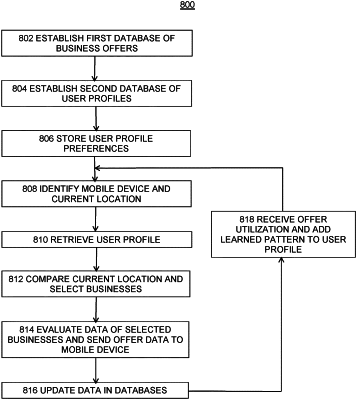| CPC G06Q 30/0267 (2013.01) [G06Q 30/0261 (2013.01); G06Q 30/0269 (2013.01)] | 11 Claims |

|
1. A system for removing unnecessary data flow from a transmission network, the system comprising:
a database; and
a computing system operatively coupled with the database and wirelessly operatively coupled over a wireless communication channel with a user portable device comprising:
at least one processor;
a communication interface communicatively coupled to the at least one processor; and
a memory device storing executable code that, when executed, causes the at least one processor to:
iteratively train a machine learning model, using a set of training data, to predict time-period-based transaction patterns of users, the training including adjusting weight coefficients during each iteration to reduce error to an acceptable level:
deploy the trained machine learning model;
run a target generation software application that stores data of information for a plurality of targets and a plurality of user profiles in the database, the information for each of the targets including a location for a target;
receive, in real-time across the wireless communication channel, user data including user identification, user transaction information indicating a transaction frequency of entity-specific transactions made by a user indicated by the user identification, and current location information from a user operated portable device, based on a GPS location function of the user operated portable device being activated, the user data including the user identification corresponding to profile data of one of the stored user profiles, the current location information being obtained via a positioning system utilizing a GPS device that includes a transceiver such that the positioning system wirelessly transmits and receives global positioning signals associated with the user operated portable device to determine positioning of the user operated portable device;
update the profile data of the one stored user profile using at least the user transaction information;
respond to receiving the user data by comparing the current location information of the user data with the locations included in the stored data of information and, based at least in part on the one stored user profile corresponding to the user identification, selecting multiple target entities each having an associated location within a predetermined distance of the current location; and
generate and transmit, in real-time, target data to the user portable device with instructions to display, via a user interface of the user portable device, respective target images each associated with a different one of the multiple selected target entities, wherein the target data is only transmitted across the wireless communication channel when the user portable device's current location is within the predetermined distance of the associated locations of the multiple target entities selected, rather than periodically transmitted, thereby removing unnecessary data flow over the wireless communication channel of the transmission network,
wherein the target data transmitted to the user portable device includes an order, in which to display, via the user interface, the target images, determined based upon the transaction frequency of the entity specific transactions according to the transaction information in the one stored user profile,
wherein the target data is generated based at least in part on leveraging machine learning functions of the deployed machine learning model to learn time-period-based transaction patterns of the user and the computing system further selects the multiple targets based at least in part upon the learned time-period-based transaction patterns of the user.
|